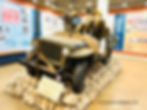Ink Flag statue at the former British Mandatory mud-brick guard station, Umm Rashrash, now a National Heritage Site in Eilat; (Photo: Janis Raisen/Israel Sites and Sights)
Eilat is known for its gorgeous beaches, spectacular diving and snorkeling, and tropical weather, but it also holds a special piece of Israeli history. Tucked away between the Red Sea shore and the Mul Hayam Mall in Eilat, is an important National Heritage Site.
During the last stage of the War of Independence, the Israeli Defense Forces started Operation Ovda, from March 5, 1949, - March 10, 1949. The goal was to secure Israel's southern border.
Two different army brigades set out to secure Eilat, (called Umm Rashrash at the time). The Gulf of Eilat was part of the United Nations Partition Plan.

Raising the Ink Flag at Umm Rashrash, March 10, 1949; (Photo: Micha Perry, Wikimedia Commons)
When the Palmach Negev Brigade arrived first, they assembled the famous makeshift Israeli Ink Flag, called "Degel HaDyo" in Hebrew, and officially raised the flag at Umm Rashrash
When the second brigade arrived, the Golani Brigade, together they sent a telegram to announce that they "...present the Gulf of Eilat to the State of Israel," according to the Eilat Museum displays.

Showing the same angle as the original Ink Flag photo posted above; (Photo: Janis Raisen/Israel Sites and Sights)
A statue was built in the exact location as the historic Ink Flag, to replicate the original flag raising and victory.

This is one of the Jeeps on display at the Eilat Museum that was used in Operation Ovda by the Palmach Negev Brigade. (Photo: Janis Raisen/Israel Sites and Sights)
When the soldiers reached the Umm Rashrash guard station on March 10, 1949, it marked the last stage in the War of Independence.
